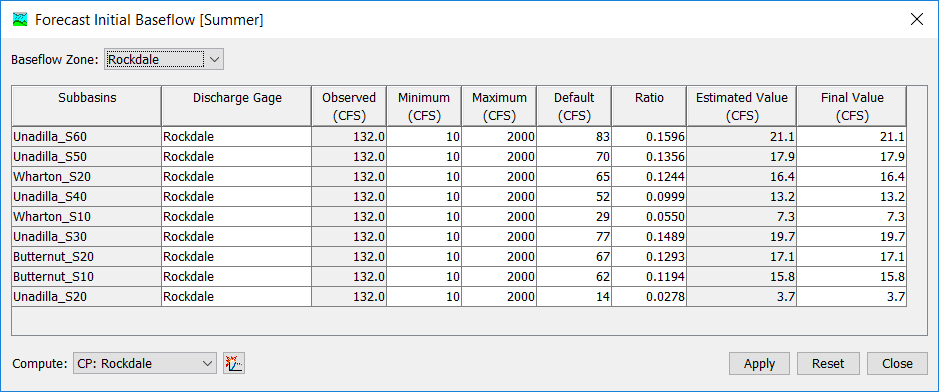Download PDF
Download page Subbasin Baseflow Initialization.
Subbasin Baseflow Initialization
Baseflow typically sets the flow condition for subbasins at the beginning of a forecast simulation. All of the available Baseflow Methods include an Initial Flow Condition at the Start of the Simulation. The initial condition may be specified as an absolute flowrate (m3/s or ft3/s) or as a flowrate per area (m3/s per km2 or ft3/s per mi2). The flow determined from the initial condition typically recedes until precipitation begins generating surface flow.
Observed flow provides one good source for calculating the Baseflow Initial Condition at the start of the simulation. In some cases observed flow may be available at the outlet of a subbasin and can be used directly as the baseflow initial condition. It is more common that there will be multiple subbasins above the observed flow location but this does not negate the use of observed flow. When there are multiple subbasins above the observed flow location, a ratio can be applied to the observed flow to calculate the baseflow initial condition for each subbasin. One approach to determing the ratio is to consider the subbasin area and the drainage area at the observed flow location. Baseflow initial calculation from observed flow can be accessed on the Compute menu using the Forecast Initial Baseflow. An example of the initial baseflow editor is shown in the following figure.
This Baseflow Initialization Feature is optional. When baseflow initialization is unused, subbasin flow is calculated purely from the Basin Model parameters, zone adjustments, and element overrides. The initialization feature may be applied at no subbasins, only one subbasin, several subbasins, or all subbasins. Using the initialization feature supersedes the Basin Model parameters, zone adjustments, and element overrides.

The Initial Baseflow editor uses the Baseflow Zone Configuration to assist in organizing data entry. The current zone is selected in the upper left corner of the editor. Each subbasin in the zone is shown on a separate row in the editor.
A Discharge Gage may be selected for each subbasin. Discharge gages must be created in the Time-Series Gage Manager before they can be selected for a subbasin. Usually the selected gage will be at the outlet of the subbasin or at some point downstream of the subbasin. The selected gage should be representative of flow conditions at the subbasin. The observed flow rate at the gage will be shown for the start time of the forecast alternative.
A Minimum and Maximum Flow Rate may be entered to qualify the use of the observed flow gage for calculating the initial baseflow. The minimum and maximum values are used in conjunction with the Default Flow Value. If the observed flow is less than the minimum, then the default value will be used instead. The default will also be used if the observed flow is greater than the maximum. The minimum or maximum can be left blank if the observed flow should be used without a lower or upper limit. Finally, the default value will be used if the observed flow is missing at the start time of the forecast alternative.
The Observed Flow from the selected gage is multiplied by the specified Ratio in order to calculate the initial baseflow estimated value. The ratio is only used if the observed flow is between the minimum and maximum values or if the minimum or maximum values are left blank. It is required for the ratio to be greater than zero and it may be greater than one. However, using a ratio greater than one should generally only be done if the observed flow is not downstream of the subbasin and significant contributing drainage area exists between the subbasin and the selected gage; this should be done only after careful analysis.
The Estimated Value is calculated from the observed flow gage using the ratio and substituting the default value according to the minimum and maximum values. At first, the estimated value is also copied as the final value. The Final Value can be edited to override the estimated value. Editing the final value may be necessary if current flow conditions diverge from the assumptions used to develop the ratio. The final value for each subbasin shown in the table will be reset to the estimated value when the Reset button is pressed.